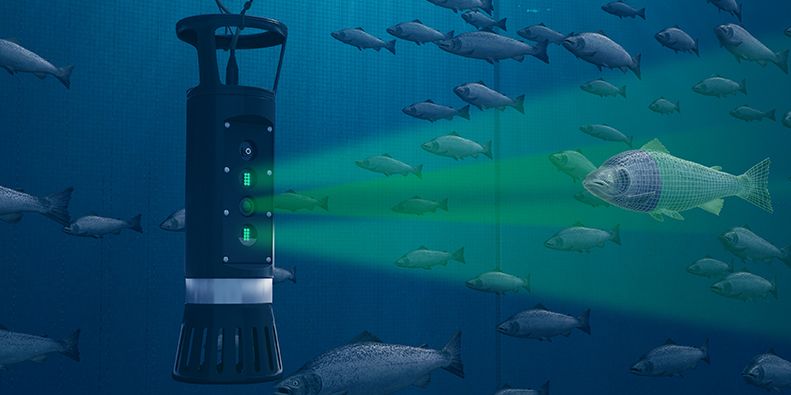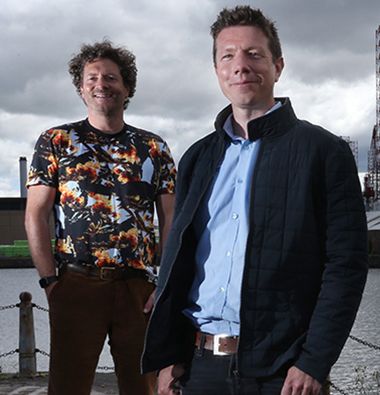Biomass counting breakthrough coming to market soon
19 July 2021

A system that can accurately measure the biomass inside a pen has long been seen as the holy grail of salmon farming. Traditional biomass estimation that is based on calculations and manual sampling is often inaccurate, leading to higher production costs.
Now Ace Aquatec is preparing to launch its A-BIOMASS®, a world first that will provide farmers with precise readings on the weight of their fish. Not only does the camera enable exact timing on when to harvest fish, but it also helps prevent feed wastage and can even be an early indicator of disease and sea lice levels.
In development for more than ten years, the biomass camera, like Ace’s deterrent offering, provides farmers with an arsenal of approaches to produce the best results based on the water quality and species. The system has been designed with stereoscopic imaging, 3D time of flight imaging, and multifrequency sonar imaging. All modules can work in isolation or combination to overcome different environmental conditions.
For example, the 3D time of flight camera is well suited to freshwater applications where a true 3D image can be captured and rotated; saltwater favours automated stereo vision, with positioning via triangulation or time of flight; and extremely turbulent or dirty water is where the acoustic camera module is most applicable.
With a focus on saltwater species, Ace is aiming to bring the saltwater module to market in November 2021 with the other modules being added in 2022. Key to all systems is the advanced machine learning and image processing which provide the intelligence not just to Ace’s in-water products, but also to out of water cameras, such as the company’s marine mammal detection triggers.
Ace Aquatec co-founder and CEO Nathan Pyne-Carter explained: ‘The core of what any of these technologies can do is the artificial intelligence. We have to be able to automatically identify a fish and identify the points on the fish, so that has been the focus of the development.
‘That is what we’ve been working on over the last few years, trying to improve the detection rates, and identify particular fish and particular features.
‘When you get beyond that, and are deploying the camera in the water, there are three approaches: time of flight which effectively uses a pulse of blue/green light that detects the distance of the fish from the lens.
‘With this, you also get the full 3D render of the fish so there is a real benefit in using that technology. But if you get particulates in front of the lens that cause distortion, then you are better using a different technology.
‘In our trials on Scottish farms, we are deploying four triangulation cameras, using machine learning. Triangulation works in exactly the same way as time of flight in that it can say how far the fish is from the camera lens.
‘We also have an acoustic camera that slots on to the bottom of our system, effectively a high frequency sonar that gives an image of the fish.
‘As a company, we don’t just focus on one technology, but try to keep looking at the best solutions for different environments.’
The current trials in Scotland are now trying to validate the weights recorded by the camera against the actual harvest weights as the farm comes to the end of its production cycle.
Pyne Carter, who came up with the concept of the biomass camera when watching his children playing interactive computer games on the Wii, said: ‘We’re also working with Napier University and Peacock Technology on state-of-the art AI techniques so the camera can be trained to detect more details in the fish – for instance, sea lice numbers.’
Alongside the development of the biomass system, Ace has created a new portal that translates the data provided by the camera into information that can be used by the customer in multiple sites. While Ace’s deterrents and electric stunner have had their own portals, the new platform will bring everything into one central location.
Leading the push to integrate intelligence across the company’s entire product range is IT specialist Donald Sutherland, who was previously at Dundee based gaming company Dog Star.
‘The portal enables farmers to access information, so with the biomass camera, for example, it will give them an immediate update on the average weight of the fish, at the top end and lower end, a vital guide to harvesting decisions,’ said Sutherland.
There has already been much interest in the A-BIOMASS® and once it is on the market the company is confident it will be able to keep up with demand, said Kevin Mulholland, Ace Aquatec Product Manager.
‘Dynamic EMS, which makes other Ace products, is the manufacturer, based in Scotland, and we don’t anticipate there being a huge gap between us going into production and having enough systems available for the initial launch, later this year.’
To get the maximum benefit from the system, it is recommended that farmers install a camera in every pen, under rental agreements, which will be available in Scotland.
‘Rental allows us to make any adjustments to the system and swap out models rather than ask customers to upgrade if they become obsolete,’ said Mulholland.
While the Ace biomass camera is being trialled in Scotland, it has a potential market worldwide, and is due to undergo trials next with king salmon in New Zealand.


